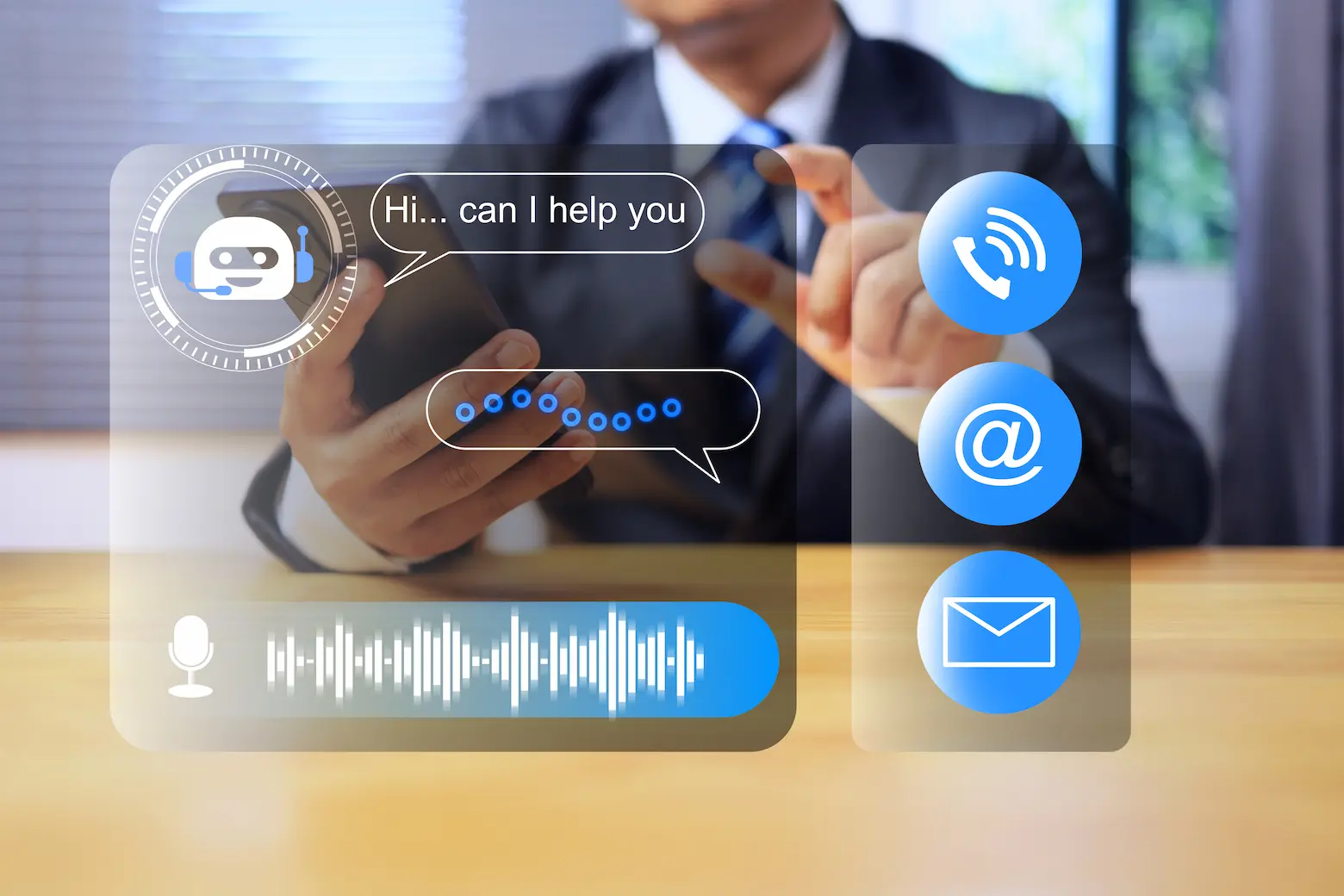Email, Chat, or Voice? The Best Ways to Deploy AI Customer Service

Customer service is experiencing its most significant transformation in decades. As artificial intelligence reshapes how businesses interact with customers, a critical question emerges: will voice agents dominate the future, or will text-based channels maintain their relevance? The answer isn't binary—it's about understanding where each channel excels and how they can work together to create superior customer experiences.
The AI Voice Revolution: Promise and Limitations
AI Voice service has reached an impressive level of sophistication, capable of handling natural conversations that would have seemed impossible just a few years ago. For routine inquiries like checking account balances, scheduling appointments, or basic troubleshooting, modern voice agents can provide instant, conversational assistance that feels remarkably human.
AI voice advantages:
The appeal is obvious: voice interactions are fast, hands-free, and feel natural to most people. Customers can multitask while speaking with an AI agent, making it particularly valuable for mobile users and those with accessibility needs. The immediacy of voice can also de-escalate frustrated customers more effectively than waiting for typed responses.
However, voice agents face several persistent challenges that text-based systems handle more gracefully:
Email Addresses Remain Problematic: Despite advances in speech recognition, capturing email addresses accurately through voice remains surprisingly difficult. The combination of spelling variations, pronunciation differences, and audio quality issues makes this simple task error-prone.
Example : Business Email with Technical Elements
Customer says: "It's jon.smith@hostcomm.co.uk"
Voice agent might capture:
- "john.smith@hostcomm.co.uk" ("jon" becomes "john")
- "jon.smith@hostcom.co.uk" (only 1 "m" in hostcomm)
Why this fails: Email names and domain names often dont follow standard patterns. The voice agent struggles to distinguish between similar-sounding words ("tech" vs "text") and often incorrectly interprets or omits special characters entirely.
These examples illustrate why many companies still require email verification through text or chat, even when the initial contact is via voice. The cost of a mis-routed email or failed communication often outweighs the convenience of voice-only capture.
Accent and Audio Quality Barriers: While AI has improved at understanding diverse accents, it's far from perfect. Regional dialects, non-native speakers, and varying speech patterns can still confuse voice systems. Add in the reality of poor SIP phone line quality—with dropped packets, compression artifacts, and background noise—and accuracy can plummet significantly.
Complex Information Challenges: Try dictating a 16-digit credit card number, a multi-line address, or technical specifications over the phone. Voice excels at conversational flow but struggles with precise data capture, especially when customers need to reference or verify information.
The Enduring Power of Text-Based Channels
Text-based customer service—encompassing chat, email, and messaging platforms—offers advantages that voice simply cannot match:
Precision and Reference: Customers can copy and paste exact error messages, share screenshots, include links, and provide detailed information without spelling concerns. The permanent record allows both parties to reference previous exchanges and maintain context over time.
Customer Control: Text allows customers to craft thoughtful responses, research answers, and engage at their own pace. They can step away from the conversation without feeling rushed or needing to explain their absence.
Privacy and Discretion: Many customers prefer text for sensitive issues or when they're in public spaces where voice conversations would be inappropriate or overheard.
The Email Renaissance: AI-Powered Efficiency
Email, often dismissed as outdated in the instant-messaging era, may be poised for a resurgence in customer service thanks to AI integration. Modern AI agents can process email inquiries with remarkable sophistication, automatically categorizing issues, extracting key information, and providing contextual responses that reference previous interactions. Furthermore the addition of AI means that the email response can be sent very quickly in a few seconds rather than days.
This AI enhancement addresses email's traditional weakness—slow response times—while preserving its strengths. Customers can provide comprehensive details, attach relevant documents, and receive thorough, well-researched responses. For complex issues requiring documentation or multiple back-and-forth exchanges, AI-powered email can be more efficient than real-time chat or voice interactions.
The asynchronous nature of email also allows AI systems to research solutions, consult knowledge bases, and even coordinate with human agents when necessary, all while maintaining a complete audit trail of the customer's history and preferences.
SMS and WhatsApp: The Outbound Game-Changer
Perhaps nowhere is the channel orchestration opportunity clearer than in outbound customer service. Traditional call centers face declining answer rates as consumers increasingly screen unknown numbers. However, SMS and WhatsApp messaging offer a powerful alternative that plays to customer preferences rather than fighting against them.
When an outbound call goes unanswered, smart systems can automatically send a text message explaining the reason for contact and inviting the customer to respond on their terms. This approach acknowledges a fundamental shift in communication preferences: many people simply don't answer phone calls from businesses anymore, but they will engage via text when convenient.
The beauty of this approach lies in its flexibility. A customer might receive a text about their service appointment during a busy workday, then respond later that evening when they have time to focus. They can ask clarifying questions, reschedule, or request additional services—all through a medium that feels natural and non-intrusive.
The Strategic Path Forward: Intelligent Channel Orchestration
The future of customer service isn't about choosing between voice and text—it's about creating seamless experiences that leverage the strengths of each channel. Here's how forward-thinking organizations are approaching this:
Start with Customer Intent and Context: Simple, routine inquiries can often be handled effectively by voice AI. Complex issues requiring documentation, precise information exchange, or extended troubleshooting are better suited to text-based channels.
Enable Seamless Channel Switching: The most sophisticated systems allow customers to start a conversation in one channel and continue in another without losing context. A customer might begin with a voice inquiry, receive a text message with relevant links and documentation, then complete the resolution via chat.
Leverage Proactive Channel Selection: Use customer preference data, issue complexity, and historical patterns to route inquiries to the most appropriate channel from the start. If a customer consistently prefers email for billing inquiries, start there rather than forcing them through a voice menu.
Build Contextual Handoff Capabilities: When human intervention becomes necessary, ensure that agents receive complete context regardless of which channel the customer used initially. The conversation history, customer preferences, and issue details should transfer seamlessly.
Industry-Specific Considerations
Different industries will see varying adoption patterns:
Healthcare: HIPAA compliance and the sensitive nature of medical information make secure text channels particularly valuable, though voice remains important for urgent situations.
Financial Services: The precision required for account numbers, transaction details, and regulatory compliance often favors text-based channels, but voice provides important reassurance for fraud alerts and urgent matters.
Retail and E-commerce: The visual nature of many shopping issues (wrong item received, damage claims) makes text with image sharing capabilities particularly powerful.
Telecommunications: Technical support often requires sharing error codes, signal readings, and configuration details—perfect for text-based channels.
Preparing for the Hybrid Future
Organisations planning their customer service technology investments should consider:
Unified Platform Approach: Invest in platforms that can handle multiple channels from a single interface, ensuring consistent AI capabilities and knowledge bases across voice, chat, email, and messaging.
Quality Assurance Across Channels: Develop monitoring and improvement processes that account for the different success metrics of each channel. Voice agents need different quality measures than chat bots.
Staff Training Evolution: Human agents will increasingly need skills in managing multiple channels simultaneously and understanding when to guide customers toward the most appropriate medium for their specific needs.
Data Integration: Ensure that customer interaction data flows seamlessly between channels to build comprehensive customer profiles and improve AI performance across all touchpoints.
%20-%20V1.webp)
Conclusion
The customer service landscape of the next few years will be defined not by the dominance of any single channel, but by the intelligent orchestration of multiple communication methods. Voice AI will handle routine, conversational inquiries where speed and convenience matter most. Text-based channels will continue to excel for complex, detailed, or sensitive interactions where precision and documentation are crucial.
The organisations that thrive will be those that make channel selection invisible to customers while optimising operational efficiency behind the scenes. They'll recognize that a customer who starts with a voice inquiry might need to switch to text to share a screenshot, then conclude with an email confirmation—and they'll make that journey feel effortless.
Rather than asking whether voice or text will win, smart businesses are asking how they can give customers the best of both worlds. In an era where customer expectations continue to rise, the answer lies not in limiting options, but in expanding them intelligently.
Subscribe to newsletter
Want to learn more about how we can help your business grow?
Related Articles
Delve into a rich tapestry of knowledge and inspiration in our blog section. Unleash the potential of your coding journey as we explore industry trends.





